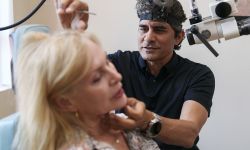Q&A: Michigan fitness club owner says how industry must change after COVID

Michigan’s 1,000-plus fitness facilities started the pandemic without an organized trade association, but owners quickly recognized their need for advocacy amid COVID-19 restrictions.
The Michigan Fitness Club Association was created in May 2020, four months before the state allowed gyms to reopen at 30 percent capacity.
Related:
- As office workers return, a Grand Rapids dry cleaner scrimps to hang on
- Michigan COVID restrictions ease as June 1 arrives
- Michigan streamlines MIOSHA workplace rules as COVID fades
- ‘A really good day for business’ as Michigan acts to lift COVID limits
A year later, the industry is still grappling with the effects of the operating constraints that nationally caused 17 percent of facilities to close and an estimated 58 percent drop in revenue. The numbers in Michigan — which still limits public access to fitness centers — may be worse.
Michigan’s gyms and other workout centers can open at 50 percent capacity starting Tuesday, June 1, and Gov. Gretchen Whitmer announced May 20 that all capacity restrictions will end by July 1.
Yet amid those changes, Michael Stack, owner of three Applied Fitness Solutions (AFS) facilities in southeast Michigan and a board member of the state fitness club association, said the industry will be dealing with the after-effects of the pandemic for some time, including whether people will even want to step foot in a gym.
About 36 percent of Michigan residents were obese before the pandemic, according to the U.S. Centers for Disease Control and Prevention, and data from the pandemic indicates that at least 40 percent of Americans added weight during it. People also have new expectations for their workouts, including digital versions.
Many owners, meanwhile, will continue to struggle to rebuild their businesses. They also plan to keep pushing on state and federal policy, including using their organization to advocate for the federal Gym Mitigation and Survival Act to establish a business recovery fund.
“We need some dedicated aid,” Stack told Bridge Michigan Business Editor Paula Gardner. Here are excerpts from the conversation.
What is the impact of the pandemic on your industry?
Statistics suggest that right now, about 17 percent of gyms and fitness centers have closed nationally. We also saw about a 50- to 60-percent reduction in revenue as an industry in 2020.
We'll survive with some changes, but unfortunately, the industry as a whole might see a contraction of upwards of 30 percent by the end of the year. So the industry’s in a tough spot right now.
What changes were happening in the industry before the pandemic?
Since 2015, the boutique fitness industry (had) been growing by upwards of 50 percent in some cases. These are places like AFS, Orangetheory Fitness, Fit Body Boot Camp, Solid Core and so on.
We were undergoing this rapid growth as an industry, and then the virtual fitness experience — the Pelotons and MIRROR Home Fitness — was starting to emerge, and obviously COVID-19 just accelerated that to a degree that no one ever expected.
Virtual workouts seem to symbolize how we reacted to the pandemic.
COVID has just put it in stark relief that we have to be an omni-channel offering. That’s not just what we can do with our clients within the four walls of our brick-and-mortar facility, but also through virtual platforms, and now every gym and fitness center has a virtual platform (for workouts).
These are things that didn't really exist in any substantive form prior to the pandemic, so there has to be a way to engage people inside and outside of your gym.
The other big change that is really necessitated by the growth of the virtual streaming fitness sector and the connected equipment sector outside of the gyms is the need to really focus on building a strong community and those strong human connections … in our facilities.
What type of fitness business does that leave at the biggest disadvantage?
The smaller mom and pop business that has some sizable infrastructure built up will struggle, now that people have so many choices and the ability to engage with multiple different platforms.
The one that could survive is the solo practitioner. So if you're a really great yoga instructor and you’re cool teaching 25 yoga classes a week, and the only payroll cost you really have is yourself…that type of studio will survive.
The big boxes and the big players, they'll survive, but the mid-range places that have reasonably high payroll costs because they have a number of practitioners and trainers working for them, they're going to get dinged in two ways. They're not going to be able to compete with the big players because they just don't have the kind of capital they would need to build the technology infrastructure.
But on the flip side, and this is the crazy part, all of this technology that's been developed recently has now really swung the leverage back towards the trainer.
I, as a solo trainer, can build my brand on one of these virtual platforms for next to no money, and I can create my own following. So now those people are going to either just drop out of the workforce entirely, and do it on their own, or command a much higher wage.
How does the new technology change your pricing?
This is the tough one because now the consumer has the expectation that their fitness experience will come with a virtual component. And so that's a cost that a company now has to incur, but I'm not convinced that they're going to be able to pass that cost directly on to the consumer, because there are so many inexpensive options out there.
It's a cost of doing business right now. And what it's going to do in the short term is drive down our profit margins. In the long term, it's going to eliminate the businesses that can't absorb that extra cost, so maybe that 30 percent I talked about (as likely to close this year) could become 40 or 50 percent if technology starts to become a capital barrier for some of these mid-level businesses.
Coronavirus really put a spotlight on public health. I put on weight, and as I look around, I see many people who added pounds, and a few who used the stress of the pandemic to work out a lot.
I really worry about the state of public health in our country coming out of COVID. If you reduce the industry footprint by 30 percent, what kind of barrier does that put in place for the ambivalent exerciser?
You could argue on some level that the industry was a little bit bloated, but what's not debatable is that people only drive so far for their exercise experience (and many won’t be able to if closures continue).
So you’re not just worrying about your business, public health is on your mind, too.
There has never been a point in time where I think we've seen this much of an acute deterioration of fitness and health levels.
COVID also was the first time that we had an acute medical event that was associated with reduced level of health and fitness and wellness, meaning like if you were overweight today, COVID could kill you tomorrow. And we've never had that happen before.
When you think about the industry struggle today, how angry do you get over the restrictions that were placed in Michigan?
When the restrictions were first put in place, I was actually a strong advocate for them because we just simply didn't know, and I think the abundance of caution approach made all the sense in the world.
My frustration and many of my colleagues' frustrations came in when there were statements made that ‘We're just looking at the science.’ (We saw) that we were in a very low transmission environment and we were not a vector for transmission.
Yet that sentiment still remained in lawmakers' minds and policymakers' minds, that we were a highly transmissible environment, so they maintained the restrictions. I think the most damning one that happened was when (the state) backed restaurants up to 50 percent (customer capacity), but they had us still at 30 percent (capacity). It was a punch to the gut.
We were never able to access data that the administration said they were referencing ... to put those restrictions on it.
Is fully reopening enough at this point?
This is a low-profit-margin business in the first place. On a good day, we're happy about 20 to 25 percent. If you start to get to a point when they are getting to less than 10 percent, then you have the concern of running negative really, really fast and it becomes unsustainable.
A lot of gyms and fitness centers are at a point where they're at those very low profit margins, if not negative.… We're just assuming the pent-up demand will eventually cause our revenues to rebound and get back to those reasonable profit margins, and that's a dangerous assumption to make. We just don't simply know what the consumer is going to do.
What do you need from policy today?
The programs they put in place initially were life-savers for all businesses and kudos to Congress for realizing that we just had to push money out there and not overthink this too much. But I think it would have been helpful to our industry for them to look a little closer at the specific needs of the fitness industry to see if some of the funding worked.
Like the Paycheck Protection Program?
We took our first PPP loan in April (2020) as soon as we could get it, and we didn't re-open here in Michigan until September. Well, we had all those months of not being able to employ anybody. That money just sat there, so for us, it's going to turn into a loan rather than a grant because we weren't able to use it during the allotted period. There’s still hope that Congress might come back and make modifications to the forgiveness (portion of the funding).
The larger policy issue is — and this is where not only the state trade association is going, but also the national trade association — is we need to work towards being recognized as a legitimate constituent on the healthcare spectrum.
COVID clearly showed us as an industry that we weren't looked at as a legitimate player in public health. We heard that our business wasn't essential (when we were closed), but we felt like we were essential to the health and well-being of the public.
How is your own business changing? Are you still operating in Ann Arbor, Plymouth and Rochester?
Rochester was the one that we were most concerned about going into COVID, because it just had the smallest membership base. We are going to be able to move our business out of our physical location into the Rochester Avon Recreation Authority, basically the local rec center. That is amazing for us because we wouldn't have been able to sustain our stand-alone facility, so all three locations still exist.
We are pivoting our business model right now. We’ve been known as a circuit training facility, and that’s become ubiquitous in our industry, so we’ll focus more on strength training.
We also are going to focus on actually reducing the size of our client base to something that we feel allows us to really connect with our community the way we want to... And be a little bit more focused on the quality of the experience rather than the quantity of the numbers. There will be more individualized instruction, more for individuals that have medical and orthopedic issues and for people who are looking for a place where they don't have to work out with a ton of other people and can feel comfortable in their own skin.
You've been through so much, but it sounds like it helped you to refocus your mission.
As tragic as this whole situation has been, and there's no way to even express the humanity of the tragedy, but the most positive thing that came out of it is we were able to hit the pause button (and make changes) with a really, really positive team. I'm excited for the fall, which is when I think we'll start to get busy again.
Business Watch
Covering the intersection of business and policy, and informing Michigan employers and workers on the long road back from coronavirus.
- About Business Watch
- Subscribe
- Share tips and questions with Bridge Business Editor Paula Gardner
Thanks to our Business Watch sponsors.
Support Bridge's nonprofit civic journalism. Donate today.
See what new members are saying about why they donated to Bridge Michigan:
- “In order for this information to be accurate and unbiased it must be underwritten by its readers, not by special interests.” - Larry S.
- “Not many other media sources report on the topics Bridge does.” - Susan B.
- “Your journalism is outstanding and rare these days.” - Mark S.
If you want to ensure the future of nonpartisan, nonprofit Michigan journalism, please become a member today. You, too, will be asked why you donated and maybe we'll feature your quote next time!




